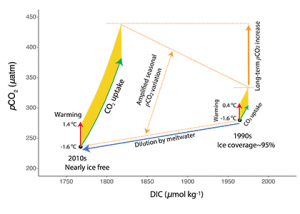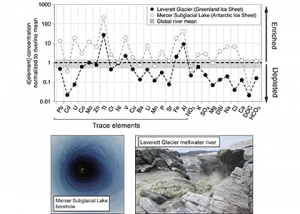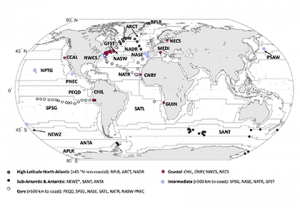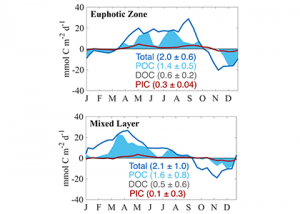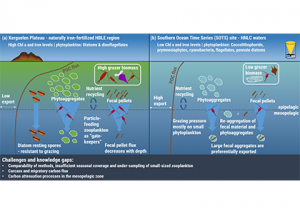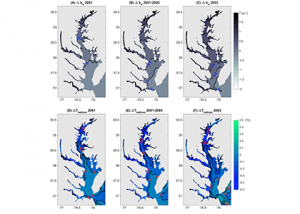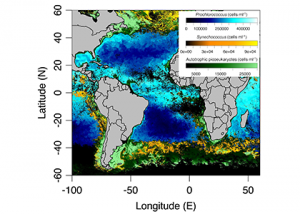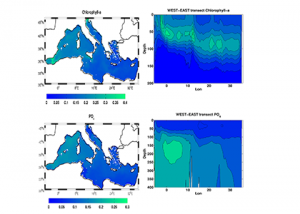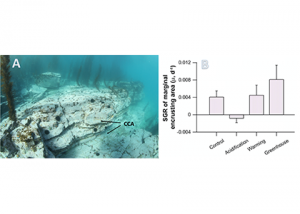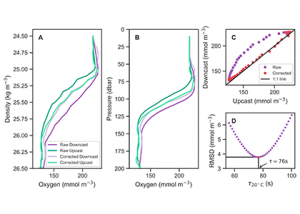If you would like to have your recent publications featured on the OCB website please contact ocb_news@whoi.edu. View our guidelines for writing a New OCB Research post.
Warming and sea ice loss over the past few decades have caused major changes in sea surface partial pressure of CO2 (pCO2) of the western Arctic Ocean, but detailed temporal variations and trends during this period of rapid climate-driven changes are not well known. Based on an analysis of an international Arctic pCO2 synthesis data […]
Read MoreTrace elements are essential micronutrients for life in the ocean and also serve as valuable fingerprints of chemical weathering. The behaviour of trace elements in the ocean has gained interest because some of these elements are found at vanishingly low concentrations that limit ecosystem productivity. Despite delivering >2000 km3 yr-1 of freshwater to the polar […]
Read MoreAuthors of a recent paper published in Global Biogeochemical Cycles conducted a detailed study of the residence times of total and dissolved iron (Fe) in the upper layers (0-250m) of the global ocean. Using historical (1980-2007) and recent GEOTRACES data, they compiled an impressive data set comprising dissolved, filtered and trap-collected particulate Fe spanning different […]
Read MoreCarbon export from the surface into the deep ocean via the biological pump is a significant sink for atmospheric carbon dioxide. The relative contributions of sinking particles—particulate organic carbon (POC) and dissolved organic carbon (DOC)—to the total export affect the efficiency of carbon export. In a recent study published in Global Biogeochemical Cycles, the authors […]
Read MoreThe Southern Ocean exhibits an inverse relationship between surface primary production and export flux out of the euphotic zone. The causes of this production-export decoupling are still under debate. A recently published mini review in Frontiers in Marine Science focused on zooplankton, an important component of Southern Ocean food webs and the biological pump. The […]
Read MoreEstuarine water clarity is determined by suspended materials in the water, including colored dissolved organic matter, phytoplankton, sediment, and detritus. These constituents directly affect temperature because when water is opaque, sunlight heats only the shallowest layers near the surface, but when water is clear, sunlight can penetrate deeper, warming the waters below the surface. Despite […]
Read MorePicophytoplankton, the smallest phytoplankton on Earth, are dominant in over half of the global surface ocean, growing in low-nutrient “ocean deserts” where diatoms and other large phytoplankton have difficult to thrive. Despite their small size, picophytoplankton collectively account for well over 50% of primary production in oligotrophic waters, thus playing a major role in sustaining […]
Read MoreThe Mediterranean Sea is a semi-enclosed mid-latitude oligotrophic basin with a lower net primary production than the global ocean. A west-east productivity trophic gradient results from the superposition of biogeochemical and physical processes, including the biological pump and associated carbon and nutrient (nitrogen, phosphorus) fluxes, the spatial asymmetric distribution of nutrient sources (rivers, atmospheric deposition, […]
Read MoreSeawater carbonate chemistry has been altered by dramatic increases in anthropogenic CO2 release and global temperatures, leading to significant changes in rocky shore habitats and the metabolism of most marine organisms. There has been recent interest in how these anthropogenic stresses affect crustose coralline algae (CCA) communities because CCA photosynthesis and calcification are directly influenced […]
Read MoreDespite its fundamental importance to the global carbon cycle, climate, and marine ecosystems, oceanic primary production is grossly under-sampled. Autonomous platforms represent an important frontier for expanding measurements of marine primary productivity in time and space, but this requires the establishment of robust, standardized methods to obtain reliable data from these platforms. Using data from […]
Read More
